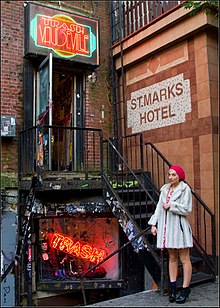trash
The term trash ([ træʃ ]; English garbage ) is applied to various cultural phenomena of the present.
The online Duden defines trash as a "direction in music, literature and film, for which content that is consciously banal , trivial or primitive and cheap production is typical". The explanation in Wahrig's dictionary is similar , where trash is described as “inferior commodity, mass product, inferior, shallow entertainment, literature or art” and as a “style of pop music ”. The term, which always has a derogatory meaning, has been adopted from English and denotes garbage, rubbish, rubbish, junk.
Movie
In the film business there is a large proportion of trash productions. They are usually not only cheaply produced and have a simple to absurd plot, but often also have technical, dramaturgical and acting weaknesses. This trash in film, along with obvious film errors, is easier to distinguish than in other art forms. A distinction must be made between intended cheap productions, which often belong to the category of B-films , and films that no longer meet today's standards due to their age and the history of how they were made, which makes them appear involuntarily funny. Producers of the genre like the famous and meanwhile cult director Ed Wood see their films as art.
watch TV
The term trash TV is used in the media and public discussion about the loss of quality of content from private as well as public television channels . In particular, scripted reality formats and reality TV (including Big Brother or I am a star - get me out of here! ), In which critics believe that voyeurism and the display of disgust take place, are used by politicians, churches, state media agencies and the advertising industry objected to (see also affect television , lower class television ).
music
Trash is a stylistic device (technique, skill or skill) in popular music that has been taking shape since the mid-1960s at the latest, is used in many different styles and is often treated as an independent genre.
Visual arts

In the fine arts, artists use rubbish and cheap mass-produced items as raw materials for collages and sculptures. These works are usually based on a subtext that is critical of society, capitalism or consumption . Georges Braque , Pablo Picasso and the Dadaists were among the first to incorporate waste and scraps of material into their pictures . At the beginning of the 20th century, the Parisian Nouveau Réalistes and the representatives of junk art in the USA produced their works solely from waste, with the aim of provoking the established art market. The Bavarian performance and TrashArt artist ADLER AF , who calls herself a "Trash Queen", used her socially critical trash performances in the German pavilion in 2011 at the Venice Biennale and at Documenta 13 in Kassel.
See also
literature
- Franziska Roller: Abba, Barbie, corduroy pants. A guide to great taste . Reclam, Leipzig 1997, ISBN 978-3-379-01586-8 .
- Keyvan Sarkhosh: ›Trash‹ as an aesthetic category of postmodernism. In: Achim Hölter (Ed.): Comparative Arts. Universal aesthetics in the focus of comparative literature. (= Hermeia. 12). Synchron, Heidelberg 2011, ISBN 978-3-939381-41-9 , pp. 367-377.
- Anette Hüsch (Ed.): From trash to treasure. On the value of the worthless in art. Publication on the occasion of the exhibition 2011/2012 in the Kunsthalle Kiel . ISBN 978-3-86678-626-4
- Lea Virgine: When trash becomes art. Trash, rubbish, mongo. Milan: Skira 2007. ISBN 88-7624-727-0
- Jonas Nesselhauf, Markus Schleich (Ed.): Banal, trivial, phenomenal. Varieties of trash . Büchner-Verlag, Marburg 2017. ISBN 978-3-941310-87-2 .
Web links
- Definition of "trash" at film.at
Individual evidence
- ↑ Trash at Duden online
- ↑ Truly. German dictionary, Gütersloh 2006. p. 1491
- ↑ Be devoured, millions! In: Der Spiegel . No. 49 , 2004, pp. 210 ( online - November 29, 2004 ).
- ↑ Lichtkreuzung, Galerie Robert Weber, Berlin ( Memento of the original dated February 9, 2014 in the Internet Archive ) Info: The archive link was inserted automatically and has not yet been checked. Please check the original and archive link according to the instructions and then remove this notice.
- ↑ Margarete Kranz: The Aesthetics of Waste ( Memento of the original from February 3, 2014 in the Internet Archive ) Info: The archive link was automatically inserted and not yet checked. Please check the original and archive link according to the instructions and then remove this notice. . pdf
